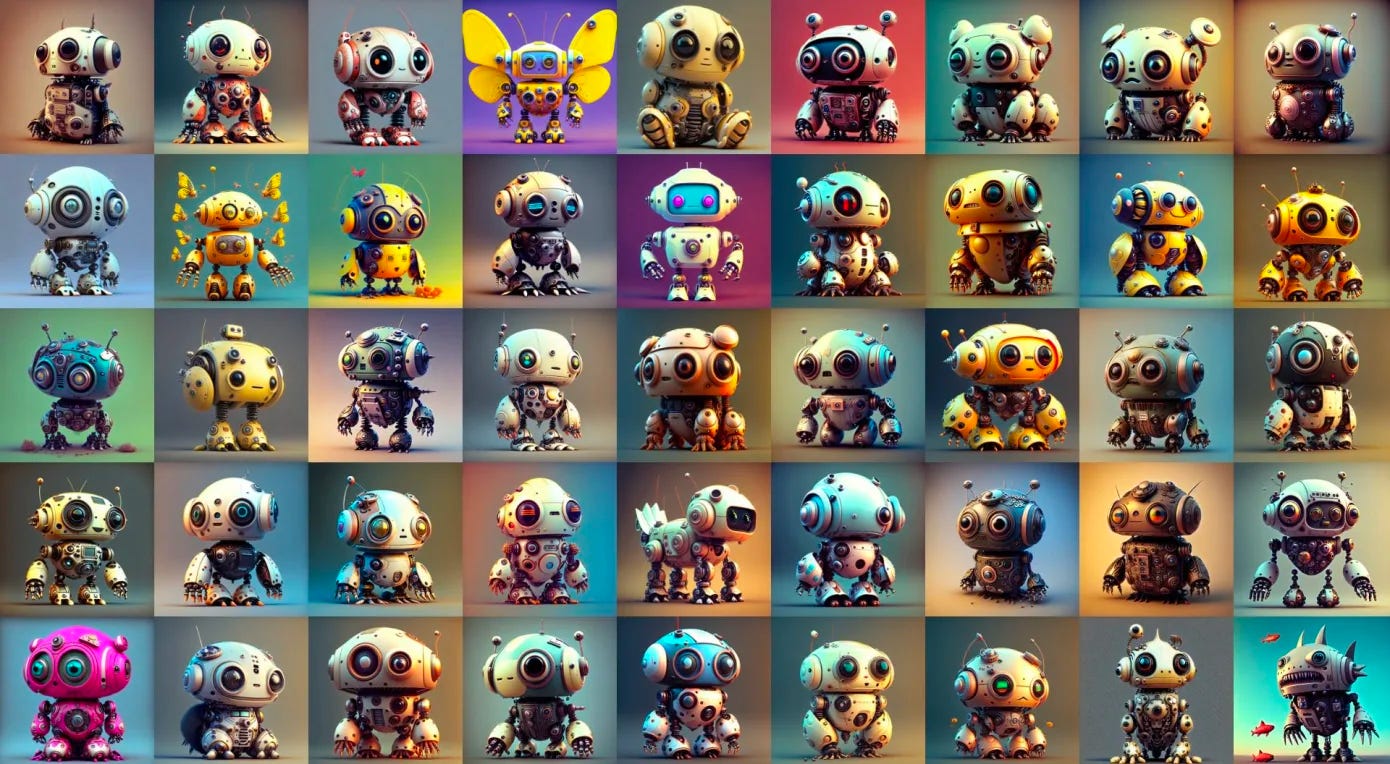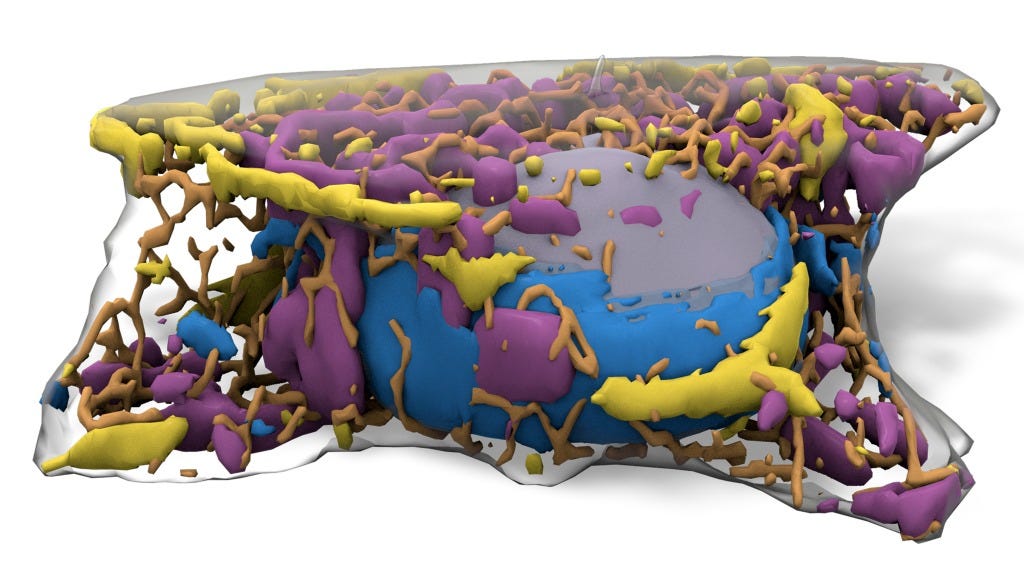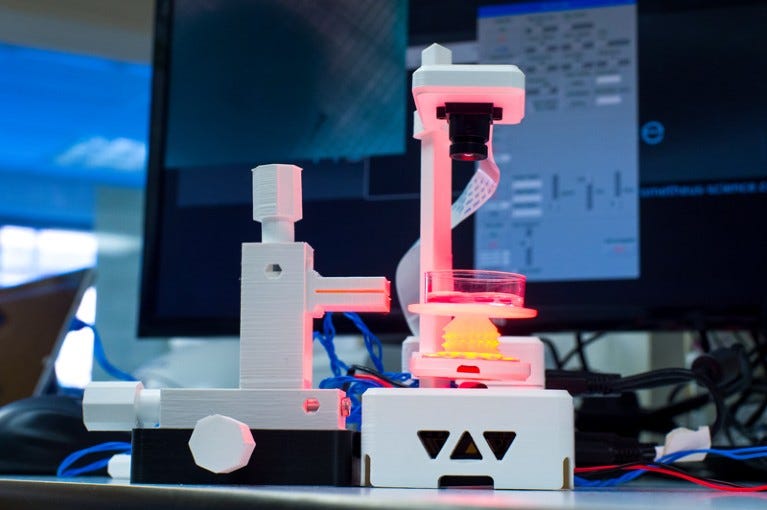Welcome to The Gameful Scientist! This newsletter explores the intersection of scientific discovery and creativity. Enjoy!

When I think about the future of biotech, I dream of glowing plants in living rooms, cloud labs at our fingertips, living medicines to cure every disease, and digital twins to track and improve health. But what if the key to unlocking this world isn't found in a lab, but in the virtual worlds of gaming?
The gaming industry continues to push the boundaries of tech. It's becoming increasingly clear that the skills, tools, and techniques developed for games hold enormous potential for unlocking new possibilities in biotech. In this article, we’ll explore the tech driving this convergence, including game engines, artificial intelligence (AI), data visualization, and 3D printing.
Welcome to Level 3.
The Power Behind Gaming
Game engines are the backbone of the gaming industry. They handle everything from the visuals, like lighting and graphics, to the logic, like the laws of physics. For example, when you drop a stone into a lake in a game, the game engine handles how the stone moves through the water, the waves on the surface, and even the sound it makes. These engines are incredibly powerful tools that can create almost anything you can imagine and serve as the foundation for a developer's creativity.
Epic Games, the company behind Unreal Engine, is valued at $32 billion. This isn’t just because of their wildly popular game, Fortnite, but also because of the potential this engine holds in other industries such as architecture, automotive design, and aerospace engineering. These industries use game engines to create virtual prototypes and simulations with real-time rendering. In Hollywood, game engines are also used to create visual effects for shows like "The Mandalorian."

Jud Waite, PM at Amazon Web Services (AWS), claims that:
The Unreal Engine is to Epic Games what AWS is to Amazon. Both companies monetize the proprietary infrastructure used to support their core businesses. Over time, these infrastructure offerings have become core businesses of their own.
But in biotech, game engines are being used to reimagine drug discovery.
The drug development process is long, and any tool that can streamline it or offer a new perspective is invaluable. Game engines are used to simulate the interactions between drugs and proteins in a virtual environment. This allows for a more efficient screening process and can even lead to the discovery of new drug targets.
C4X Discover uses the Unreal Engine and its tool 4Sight to develop medicines in virtual space, enabling chemists to easily design and test molecular variations. Dr. Charles Blundell, co-founder of C4X, claimed to have even spotted flaws in a molecule he’d worked on for years after seeing it in VR, due to the unique perspective.
The potential of these game engines to be applied to biotech are limitless. Simon Jones, Director of Unreal Engine Enterprise, says:
Examples off the top of my head are therapeutic pain relief – they’re building applications to distract burns victims when they’re having their bandages replaced. In therapeutic treatment there’s efforts being made in helping spina bifida patients to walk, they’re designing care homes around the colour vision deficiencies present in certain types of Alzheimer’s, they’re training medical staff such as optometrists. It’s exploding.
The Brain of Gaming and Biotech
When you throw a headset on to play a video game, you want to be fully immersed in that world. AI makes this possible by creating more realistic and interactive non-playable characters (NPCs) through machine learning (ML). NPCs are no longer limited to simple pre-programmed routines. They now have unique personalities, can respond to player decisions, and can even form alliances.
Adaptive AI is also making a big impact in the gaming world. Games can now learn from a player's style and strengths, creating a personalized experience that keeps players engaged. For example, racing games like Forza Horizon 5, use adaptive AI to simulate real race car drivers, and e-athletes can create AI "fingerprints" of their gaming style for others to challenge.
The generative AI revolution is also here. This is a different type of AI that uses ML to understand the underlying patterns in existing content like audio, video, images, and code, to generate new and unique results. Generative AI is already transforming the gaming industry by enabling developers to create original content. Fast.
Companies like Scenario are creating custom generators that match a game's graphic style. With simple word-based prompts, artists can generate an endless amount of assets for their projects, leading to the potential for games that are personalized to individual player preferences. I got early access to Scenario's platform in December and have been combining BioRender and Midjourney to generate some bio-themed assets. I’ll post some examples on my Twitter.

But AI extends beyond the digital world and into the field of biology, through the use of deep learning. Elliot from
does an excellent job shining light on this area.Deep learning is based on artificial neural networks, which are made up of neurons connected in layers. These networks learn from examples, rather than being programmed explicitly. The more data and neurons in the network, the better the results. Deep learning is now state-of-the-art for modeling DNA, RNA, and proteins at the molecular level, predicting cellular functions, and designing synthetic genomes. This has enormous potential for improving human health and the physical world, like reducing climate change and promoting sustainable production methods.
For example, NVIDIA partnered with Evozyne to develop two new proteins - one to treat a congenital disease and the other to reduce global warming by consuming carbon dioxide. AI is also being used to study the internal structures of human cells, such as the Allen Integrated Cell, a 3D model of a living human cell created by analyzing images of live human stem cells.

The intersection of gaming and biotech is exciting, as advancements in one field can impact the other. For example, adaptive AI models used in gaming could be used to create personalized treatment plans by analyzing a patient's medical history, symptoms, and responses to previous treatments. Generative AI models used in gaming could also be used to develop new, life-saving drugs. AI is transforming our world in incredible ways and its impact on both gaming and biotech is an exciting one to follow.
Making Sense of it All
Data should tell a story. When visualizing it, you want to clearly present the key points or make it as easy as possible for people to analyze the data and form their own conclusions.
Data visualization is essential in both gaming and biotech for understanding and communicating complex information. In gaming, data visualization is used to present key information, such as player health, score, and experience, and to improve gameplay strategy with post-game analytics.
Inspiration from game design can enhance data visualization. For instance, in choose your own adventure (CYOA) games there isn’t a single linear storyline. You face branching narratives, where your in-game choices can take you through an entirely different storyline than your friends.
Biology is the same. Blood stem cells, for instance, can become any blood cell type in the body. By understanding cell fate decision making, stem cells can be guided along a path to become immune cells with desired properties. Scientists can use this information to create cancer-killing T cells in a dish. The dynamic data can be represented as decision trees, where each node signifies a branching point that can change the path of the process.
Similarly, games like Minecraft are fully exploratory and demonstrate the emergent properties of the choices we make. These games enable players to define their own victory conditions and modify the possibility space through their actions. This serves as a good analogy for managing the dynamic datasets in research.

Biotech faces a number of data visualization challenges, which needs to be solved to make sense of the large amount of data in the life sciences. Traditional data visualization techniques such as heat maps, 3D renderings, network graphs, and pathway maps can be used to interpret high-dimensional datasets, but there are limitations to these techniques.
Dashboards offer a solution. Leading providers in this space, like Tableau and Benchling, enable scientists to create beautiful and intuitive dashboards. These provide a better way to explore dynamic datasets, allowing for multiple insights to be collected from the same data and tailored to different research goals.
Elijah Meeks, CIO of Noteable, writes:
We often design our data visualization views as if the charts are atomic and unrelated to each other, or if they are they are only in a navigational sense, rather than thinking systematically about how one chart informs another and whether that relationship is one of equals or with one chart as context to the other.

In the same way that video games offer players maps and rooms full of puzzles to solve, research holds the mysteries of the natural world waiting to be unlocked. In this sense, insights from data can be compared to the rewards and treasures found in a game. And just as players have to manage their inventory to advance in a game, scientists need to also organize and analyze their insights to draw conclusions, make connections and advance their research. With an organized inventory management system, scientists can access, apply, and analyze their data more efficiently and see the bigger picture in their work.
I’ve learned over the years that storytelling is a superpower, and scientists aren’t traditionally good at it.
By taking inspiration from game design, data visualization tools can be improved to reveal hidden assumptions and knowledge gaps, leading to new, impactful scientific discoveries.
Building a Better World
3D printing is changing the way we play, heal and do science. At its core, 3D printing is a technology that creates 3D objects by layering and fusing materials together. In the gaming industry, it allows players to personalize their play with unique accessories and custom-made game pieces. For instance, you can now design and print your own chess set or figurines based on yourself.
In biotech, instead of plastics, 3D bioprinting deposits layers of biomaterial, including living cells, to create medical devices, prosthetics, and human tissue. Companies such as Oxford Performance Materials are using it to create orthopedic implants for Ukraine war victims, while United Therapeutics is using it to create lung tissue for patients. Scientists at Osaka University have even used 3D bioprinting to replicate a cut of Wagyu beef.
One of my favorite applications of 3D printing is in open science. With the growing accessibility of open-source designs and affordable 3D printers, scientists are embracing “do-it-yourself” (DIY) tools to pull of some incredible things. Advanced diagnostics, for instance, are now accessible in resource-poor regions without the need for expensive equipment or trained technicians. Fernan Federici, a molecular biologist in Chile, 3D printed his own $250 fluorescent microscope instead of purchasing one for $25,000.
We needed a specific application — getting fluorescent time-lapses of bacteria growing — and we could do it with open hardware.
Awesome.

Customizability is another advantage of 3D printing in science. For instance, the 3D printable OpenFlexure microscope, which costs around $262, was originally designed for labs in the UK to customize their optics. But its low cost and portability also has it being used in Tanzania to diagnose malaria.
Jephias Gwamuri, Director of Research and Innovation at Great Zimbabwe University, is even using 3D printing to produce low-cost face shields, personal protective equipment (PPE), and ventilator parts for the COVID-19 pandemic.
The fact that if you can dream of anything, you go to your garage and then start printing it out, it’s so empowering.
The rise of open science and 3D printing is empowering scientists to conduct their own experiments, create custom equipment and make scientific advances accessible in remote regions. With the ability to print anything you can imagine, 3D printing is a truly liberating force and I’m excited to see what other impactful things people create.
The Future of Interaction
Ben Buchanan, from
, paints a vivid picture of what the world could look like in 2033.Virtual reality (VR) and augmented reality (AR) are changing the future of interaction and they're poised to shake up multiple industries, including gaming and biotech. In gaming, VR and AR allows for more immersive environments. In biotech, VR and AR are being used to simulate surgical procedures, and help patients recover from injuries. The possibilities are endless, and there's so much to explore in this exciting space.
I've been taking feedback from the community. The consensus was to save this exploration for a future article. So stay tuned!
The intersection of gaming and biotech presents some exciting possibilities. By combining unique perspectives and approaches, new discoveries and innovations can be made. Let's explore this space together and see what it can offer.
See you next week :)
Thanks for reading The Gameful Scientist! I’d love to hear your thoughts below.
Feel free to contact me here or chat with me on Twitter @ATrotmanGrant :)


Check out: https://www.molecularreality.com/